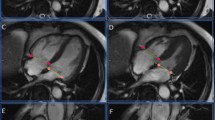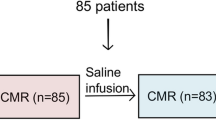Summary
To study reliability and reliable indices of quantitative assessment of right ventricular systolic function by time-intensity curve (TIC) with right ventricular contrast, 5% sonicated human albumin was injected intravenously at a does of 0.08 ml/kg into 10 dogs at baseline status and cardiac insufficiency. Apical four-chamber view was observed for washin and washout of contrast agent from right ventricle. The parameters of TIC were obtained by curve fitting. The differences of parameters were analyzed in different states of cardiac functions. Among the parameters derived from TIC, the time constant (k) was decreased significantly with decline of cardiac function (P<0.001). But half-time of decent of peak intensity (HT) and mean-transit-time (MTT) of washout were increased significantly (P<0.001). The k was strongly related to cardiac output of right ventricle (CO) and ejection fraction (EF) of left ventricle and fractional shortening (FS) of left ventricle. Right ventricular systolic function could be assessed reliably by the parameters derived from TIC with right ventricular contrast echocardiography. The k, HT and MTT are reliable indices for quantitative assessment of right ventricular systolic function.
Similar content being viewed by others
References
Spencer K T, Garcia M J, Weinart Let al. Assessment of right ventricular systolic and diastolic performance using automated border detection. Echocardiography, 1999, 16: 643
Mareds R H, Bednrz J, Coulden Ret al. Ultrasonic backscatter system for automated online endocardial boundary detection. J Am Coll Cardiol, 1993, 22: 839
Xia H Q, Liu G Q. Cardiac function in clinical practice. Beijing: Chinese Publishing House of Medical Sciences (Chinese), 1993, 301–304
Wang X F. Echocardiography. 3rd ed. Beijing: People’s Medical Publishing House (Chinese), and techndogy. 1999, 202
Xie F, Meltzer R S. Determination of ejection fraction from contrast echocardiography using videodensitometry in an in vitro model. J Ultrasound Med, 1988, 7(10): 581
Jonathan R L, Christion F, Kevin Wet al. Myocardial perfusion characteristic and hemodynamic profile of MRX 115, a venous echocardiographic contrast agent, during acute myocardial infarction. J Am Soc Echocardiogr, 1998, 11: 36
Kaul S. Quantification of myocardial perfusion with contrast echocardiography. Am J Cardiac Imag. 1991, 5: 200
Robert S, Greenberg M, Georg Aet al. Analysis of regional cerebral blood flow in dogs, with an experimental microbubble based US contrast agent. Radiology, 1996, 201: 119
Strauss A L, Beller K D. Colltrast ultrasonography for 2-D opacification of heart cavities, peripheral vessels, kiney and muscle. Ultrasound in Med & Bio, 1997, 23: 975
Author information
Authors and Affiliations
Additional information
WANG Lin, male, born in 1965, M. D., Ph.D.
Rights and permissions
About this article
Cite this article
Lin, W., Youbin, D., Tianliang, L. et al. Quantitative assessment of right ventricular systolic function by the analysis of right ventricular contrast time-intensity curve. Current Medical Science 24, 607–609 (2004). https://doi.org/10.1007/BF02911370
Received:
Published:
Issue Date:
DOI: https://doi.org/10.1007/BF02911370




